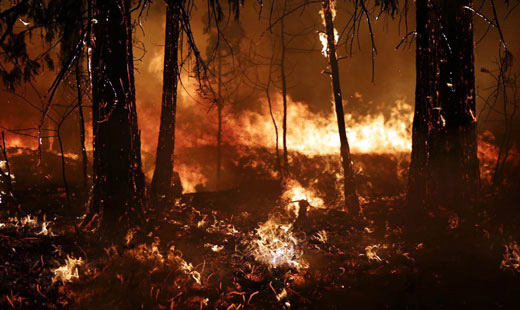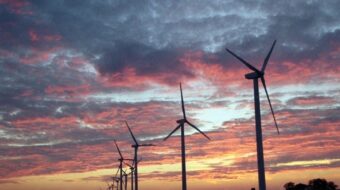
As the changing climate continues to trigger disaster and disruption, California’s Rim Fire, which has burned 235,841 acres, is the latest to be added to this year’s list of brushfires. That list is seemingly growing nearly as large as the fires themselves.
With over 5,000 firefighters dispatched to combat the blaze, it was described yesterday as being 70 percent contained, but triumph is still a long way off: Officials estimate the fire will only be fully contained by September 20. After being triggered by an unknown cause on August 17, it is currently burning parts of the Sierra Nevada region, which includes the state’s Tuolumne and Mariposa counties. The flames are now spreading eastward, into Yosemite National Park.
Rough terrain and erratic winds haven’t helped the situation, and even water from planes and helicopters, which sought to combat the fire from above, have had an uphill battle on their hands. This wildfire has posed a particularly dire situation by presenting unique threats: it affected the local power infrastructure when it prompted a precautionary shutdown of three hydroelectric power plants serving San Francisco. It also threatened one of San Francisco’s main water sources, the Hetch Hetchy reservoir, which serves about 85 percent of the city’s water supply, by filling the water with ash.
And, of course, the wildfire is causing plenty of bucolic havoc: the U.S. Forest Service has made it a high priority, as it is threatening the giant sequoia trees of Yosemite National Park. Sequoias (which include redwood trees) are ancient and endangered, and after recent human interference with their habitat, it would seem the Forest Service is on high alert in the case of new dangers to the trees.
Scott Gediman, a spokesman for the park, explained, “All of the plants and trees in Yosemite are important, but the giant sequoias are incredibly important both for what they are and as symbols of the national park system.”
Park officials, meanwhile, are dealing with displaced animals after the mayhem; these include Western pond turtles and a number of bald eagles and their nests.
The problems might seem innumerable, but the harsh truth of the matter is that this has apparently become the new “normal,” at least over the course of the past few years. “It’s just been a long, hot, fiery summer,” said Beth Pratt, California director for the National Wildlife Federation. “I have never seen so much fire.”
And there’s one more atypical aspect to this wildfire: it’s capable of creating its own weather patterns. Julie Hutchinson, information officer for the California Department of Forestry and Fire Protection, said, “As a fire gets big and starts consuming more and more vegetation, all that heat that’s been generated goes up into a smoke column and it will practically create its own thunder head.” From that point, she added, “it has the same ability as a thunder head does to break loose and change the weather patterns in and around it.” This then leads to strong, unpredictable winds, which only worsen the situation.
Hutchinson then drew the obvious connection to global warming, noting that the particularly dry conditions in the region this year have made Yosemite “very receptive” to the wildfire’s threat. “We were seeing summer temperatures in April and May,” she remarked. “The grass, the brush, the timber – they are very dry, and they’re stressed.”
Photo: Trees near Yosemite National Park burn from the Rim Fire. Jae C. Hong/AP












Comments